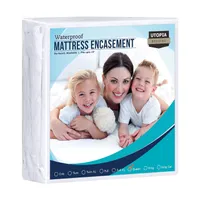How to prevent bed bugs getting into your mattress – 3 actions to take now
Reduce the chance of bed bugs infesting your mattress with these expert tips

Bed bugs are prolific. Once inside your home they’ll spread like wildfire, quickly infesting your furniture, mattress, bedding and curtains. Getting rid of bed bugs is very hard without the help of pest control, and when these critters bite your skin, those bites can feel itchy and sore for a while.
The telltale signs of bed bugs in your bedroom include a musty odor, blood stains on your mattress and bedding, eggs that measure around 1mm in size, shed skin, feces, and not to mention actual bedbugs crawling around at night. In the day they like to hide in mattress tufts and folds.
Even the best mattresses with fully hypoallergenic designs aren’t immune, so being prepared is your best defence. With that in mind, here are three things you can do right now to prevent bed bugs from infiltrating your mattress. Plus, if you feel that your mattress is now beyond help and would like to dispose of it ASAP, check out our guides on how to get rid of an old mattress and how to dispose of a mattress with bed bugs.
How to prevent bed bugs in your mattress
1. Invest in a zippered mattress cover
A basic mattress protector won’t save you from bed bugs. Instead you’ll need a zippered mattress encasement. This piece of fabric slips over your entire mattress, covering the top, bottom and all four sides. You then zip it shut.
If you don’t have bed bugs, a mattress encasement will keep the critters out. If you do have bedbugs, the mattress encasement keeps the bugs sealed inside until they die and you can dispose of the mattress safely.
2. Clean, vacuum and steam your mattress
You don’t get bed bugs just because your home is dirty. However, regular cleaning of your mattress helps you stay on top of any potential critters, bacteria, mold and allergens.
According to the New York State Department of Health, bed bugs do not fly or jump. However they crawl quickly and are active at night, choosing to hide in the day.
Now is the time to learn how to clean a mattress properly. We recommend stripping all bedding and putting it on a hot wash: that includes your duvet and pillows too, but check the instructions if you have down bedding.
Get instant access to breaking news, the hottest reviews, great deals and helpful tips.
Vacuum the top, bottom and sides of your mattress, then steam clean every inch of it. Leaving it in direct sunlight to dry helps kill dust mites, mold and bacteria. Finish by vacuuming your bed frame, checking for any signs of bedbugs there too. If after cleaning your mattress you feel like it is beyond rescue, read our guide on how to dispose of a mattress with bed bugs.
In addition to cleaning your mattress, remember to change and wash your sheets weekly as bed bugs are one of the many things that can happen when you don't change your sheets often.

3. Check all other furniture in your home
Mattresses aren’t the only places bed bugs love to live, so check the rest of your furniture, curtains and throws. Unfortunately there are many ways bed bugs can invade your home, including from a neighboring property that already has an infestation.
Places to check include your couch, chairs, clothes, and box spring or divan bed base. Remember, the signs of bed bugs include a musty odor, blood stains, eggs or shed skin, and tiny dark specks of feces.
How to choose a good bed bug mattress cover
You’ll need one that covers the top, bottom and all four sides of your mattress. Make sure it's designed especially to ward off bed bugs or to keep them trapped inside if you already have an infestation on your hands.
A good bed bug mattress cover should be machine washable and able to withstand a very hot wash. Ensure it comes in the right size for your mattress too. Here are our top three bed bug mattress cover picks:
SureGuard Mattress Encasement: from $42.97 at Amazon
This is hands-down the best bed bug cover you can buy for your mattress. It’s waterproof, hypoallergenic and fully zippered to encase all six sides of your mattress. Invisi-Zip and SureSeak technology fully seal off your mattress from bed bugs. It fits a range of mattress heights too, from 6 inches to 20 inches.
Utopia Bedding Zippered Mattress Encasement: from $15.75 at Amazon
While this isn’t as high-tech (in fabric terms) as the SureGuard cover, it’s still waterproof and offers that all-important protection for the top, bottom and sides of your mattress. It’s also affordable, which is why it’s the best-selling bed bug mattress cover on Amazon.
Linenspa Zippered Mattress Encasement: from $19.99 at Amazon
The big sell with this Linenspa cover is that it ‘sleeps quiet’ so you won’t hear it rustling away beneath you whenever you change position in bed. Its waterproof and machine washable, and while it fits all mattress sizes, it doesn’t offer the same range of heights as the SureGuard.
Are bed bug sprays safe to use on mattresses?
Bed bug sprays are loaded with chemicals, which are needed to kill these pesky critters. But they can also lead to discoloration of your mattress or even change the feel of the fabric on the top layer.
Bed bug feces are made up of digested blood, so their droppings will be a dark rust or black color. They are tiny and hard to miss.
Our best tip is to check the care instructions for your mattress beforehand and to read the full instructions for the bed bug spray you want to buy. Some, such as the Hot Shot Bed Bug Killer, can be used on most mattresses as long as you don’t saturate the mattress:
- Don’t spray the entire surface of your mattress
- Don’t treat every inch of your box spring with bed bug spray
- Allow the spray to dry before you sleep on your mattress
Bed bug spray can be used on bed frames too, as well as in furniture such as bedside cabinets and drawers. Always read the instruction label on the spray to find out what materials it should not be used with.

Claire is a Certified Sleep Science Coach and the Managing Editor of Sleep at Tom's Guide. She curates our mattress guides and oversees our rigorous mattress testing procedures. Claire has over 16 years' product review experience and is connected to a wealth of globally renowned sleep experts including mattress designers and buyers, neuroscientists, and doctors of sleep medicine. As the Managing Editor of our Sleep and Mattress Team, Claire is responsible for all mattress and sleep content published on Tom’s Guide and is our expert on Saatva, DreamCloud, and Nectar mattresses. Claire is also certified to advise people on how to choose a mattress that suits their needs and budget, as well as helping them to create a nighttime routine and bedroom environment that helps them sleep better.



